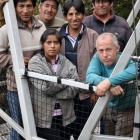Patience - A Prerequisite For Gardeners
By Dave Havard
First time, and even seasoned gardeners, who have moved here from “banana beltsâ€, may take a few hard-knocks if not forewarned of limitations of a short growing season. Don’t let that diminish the urge to grow something. Rewarding success is still attainable with the right approach to gardening practises for our area.
Snowmelt that soaks our soils leaves them cold and wet in early spring. On a sunny day the surface will often appear dry, and there is temptation to start working up a seedbed. Bad idea! Just below the surface there will be lots of cold moisture, and mixing of the dry-looking top with the wet soil below it, results in a lumpy surface and soil never properly surrounds seeds. Germination, if any, will be spotty.
Even when the dryness of soil extends deep enough to permit successful seedbed preparation, it will still maintain a soil temperature that is often too low for seed germination. In fact, it is better to err on the side of being late, rather than early, for the spring start in seeding, for a number of reasons.
Seeds sown into an unduly cold soil often rot. Those that may germinate will usually be vulnerable to a soil-borne fungus knows as “damping offâ€, which thrives at low soil temperatures.
Proven studies have also shown that most seeds won’t germinate until the soil temperature reaches at least 4.5˚C. As the soil temperature rises, which it gradually does, germination is faster. At a temperature held at 4.5˚C it takes 42 days for beet seeds to germinate and 51 days for carrot seed to pop up. But when soil temperatures reach about 29˚C, research has shown that these seeds germinate in about a week!
While there should be no undue rush to get seeds in the ground, once it is really dry enough to prepare it for them, there are some real advantages to an early-prepared seedbed. It offers weed control opportunities that should be taken. Rarely will a prepared seedbed be without weed seeds, ready to germinate (cold soils don’t bother weeds!). Let them come up, hoe them out, and even if it means delaying seeding, wait until a second batch shows itself, and repeat the slaughter of unwanted seedlings that would otherwise come up among your intended crop, if you had already seeded. This process can be extended, by staggering seeding dates, leaving things like carrots to a later date, so that you won’t likely have to be on hands and knees in order to find your seedlings amongst a labyrinth of weed seedlings.
There is another advantage in waiting for optimum conditions for progress of your plants. Most things hardly move after emergence above soil, until air temperatures reach about 5.5ËšC and start to produce heat units. So even if germination takes place successfully in a cool soil, once seedlings break through, air temperatures are likely to be relatively low too, and growth will stagnate.
If all that bad news has cooled ardour for an early start, there are a few vegetable seeds that will germinate in a relatively cool soil, and once breaking surface, are also more tolerant of cool air temperatures to which they will be exposed, and even light spring frosts don’t stop them in their tracks. Lettuce, green onions, parsnips and spinach will all germinate at soil temperatures almost five degrees lower than most seeds. So if you are itching to get started those should be your choices. And if you really want something early from an outdoor garden, go to the extra trouble of starting perennials, rhubarb and asparagus. Once established, these perennials produce a very early harvest.
It does seem that global warming is lengthening our growing season somewhat, but we still have to wait for soils to warm in the spring, after they have absorbed soil-chilling snow melt. It would be folly though, to suggest a specific gardening start-up date. There are so many variations to consider; soil types, microclimates, and the vagaries of spring weather patterns. Suffice to say, mid-May is a safe bet, most likely to meet with success rather than failure. In any event, it helps to be philosophical, if gardening is your thing. Most gardeners are. Good luck!
As a long time resident of the Bulkley Valley and author of Gardening Between Frosts, Dave Havard is a fountain of information and insight and his discussion period “Understanding Your Northern Garden”, in late January 2008, appealed to northern gardeners of all experience levels.
Bulkley Valley Food Directory.
Comments
Be the first to comment on this story. Use the form below.

